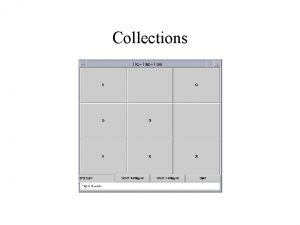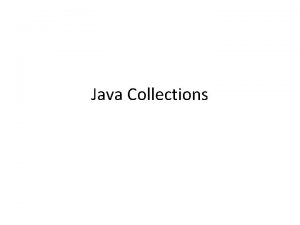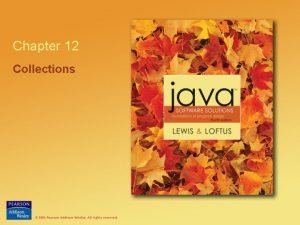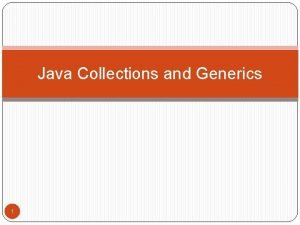Collections The Plan Why use collections What collections






















![Sprites in Animation. Canvas public void update. Sprites() { if(dirty) { array=(Sprite[])sprites. to. Array(new Sprites in Animation. Canvas public void update. Sprites() { if(dirty) { array=(Sprite[])sprites. to. Array(new](https://slidetodoc.com/presentation_image/e057147fd7d078269447cf20da6102c2/image-23.jpg)








![Practice Complete the following method //return all Sprites intersecting with target Sprite public Sprite[] Practice Complete the following method //return all Sprites intersecting with target Sprite public Sprite[]](https://slidetodoc.com/presentation_image/e057147fd7d078269447cf20da6102c2/image-32.jpg)

- Slides: 33

Collections

The Plan ● Why use collections? ● What collections are available? ● How are the collections different? ● Examples ● Practice

Why use collections? Consider the code below. What if you wanted 1000 grades? Why is this code not designed well? int grade 0, grade 1, grade 2, grade 3, . . . , grade 100; grade 0=Integer. parse. Int(field 0. get. Text()); grade 1=Integer. parse. Int(field 1. get. Text()); . . . grade 100=Integer. parse. Int(field 100. get. Text()); int sum=grade 0+grade 1+grade 2+. . . +grade 100; average. set. Text(“average is “+sum/100. 0);

Collections & Loops Recall: – Loops ● ● ● group repeatedly executed code for uniformity make the number of repetitions easily changeable can be combined with selection to make more complex algorithms

Collections Motivation Collections help enable ● declaring multiple variables ● naming multiple variables ● grouping similar variables under one name ● grouping similar code that acts on the variables ● changing the number of variables easily ● implementing more complex algorithms

Why use collections? The code below uses an array to average the 1000 grades. What change would make it do 10 grades? int[] grade=new int[1000]; int sum=0; for(int i=0; i<grade. length; i++) { grade[i]=Integer. parse. Int(field[i]. get. Text()); sum+=grade[i]; } average. set. Text(“average is “+sum/grade. length);

What an array looks like grade 45 76 44 87 98 56 77 grade is an array grade[i]is an int arrays are only one way to collect variables . . . grade[n-2] grade[n-1] 62 92

What collections are available? ● Arrays ● java. util. Collection ● – Hash. Set – Linked. List – Linked. Hash. Set – Array. List java. util. Map – Hash. Map – Tree. Map

Arrays ● Store primitives or particular Objects ● Size is immutable ● Contain length field ● Is an Object ● Indexed 0 to length-1 ● Can generate Array. Index. Out. Of. Bounds. Exception

java. util. Collection ● Store Objects directly ● Size is typically dynamic ● Has a size method ● Is an Object ● ● Indexing varies Has to. Array(Object[]) method for converting to an array.

java. util. Map ● Store Object-to-Object mapping ● Size is typically dynamic ● Has a size method ● Is an Object ● Indexing by keys ● ● Use key. Set(). to. Array(Object[]) method for converting keys to an array. Use value. Set(). to. Array(Object[]) method for converting keys to an array.

Hash. Set ● Fast for – insertion – removal – checking membership ● Uses 1 -way function (like used with passwords) ● Not great for – ordering – iterating over members – memory use

Linked. List ● ● Fast for – insertion at ends – removal at ends Slow for – insertion in middle – removal from middle – checking membership ● Minimal memory waste ● Used for stacks and queues

Linked. Hash. Set ● ● Combines good elements of Linked. List and Hash. Set Fast – insertion – removal – check for membership ● Keeps insertion and removal order ● Fast for iteration ● Memory still underutilized

Array. List ● ● Fast – insertion – removal – random access Slow – ● check for membership Great for – iterating over members – memory use – ordering

Hash. Map ● Like the Hash. Set except contains key->value mapping.

Tree. Map ● ● Relatively fast – insertion – removal – checking membership Best for maintaining order – – always in sorted order by keys uses the compare. To method

Arrays ● Fastest – insertion – removal ● Very general purpose ● Immutable size can be a problem ● When full, most memory efficient ● Best for holding primitives ● Best when used in conjunction with Collections and Maps

Examples ● ● Sprites in Animation. Canvas – Linked. Hash. Set – array Alarms in Frame. Advancer – ● Tree. Map Shapes in Blur. Sprite – Linked. List

Sprites in Animation. Canvas public class Animation. Canvas extends JPanel { private Linked. Hash. Set sprites; private Color background=Color. WHITE; private Sprite[] array; private boolean dirty;

Sprites in Animation. Canvas public void add. Sprite(Sprite sprite) { sprites. add(sprite); dirty=true; }

Sprites in Animation. Canvas public boolean contains. Sprite(Sprite sprite) { return sprites. contains(sprite); }
![Sprites in Animation Canvas public void update Sprites ifdirty arraySpritesprites to Arraynew Sprites in Animation. Canvas public void update. Sprites() { if(dirty) { array=(Sprite[])sprites. to. Array(new](https://slidetodoc.com/presentation_image/e057147fd7d078269447cf20da6102c2/image-23.jpg)
Sprites in Animation. Canvas public void update. Sprites() { if(dirty) { array=(Sprite[])sprites. to. Array(new Sprite[0]); dirty=false; } for(int i=0; i<array. length; i++) { if(array[i]. is. Destroyed()) { remove. Sprite(array[i]); } array[i]. update. Internal(); } }

Sprites in Animation. Canvas private void paint. Sprites(Graphics 2 D brush) { if (dirty) { array = (Sprite[]) sprites. to. Array(new Sprite[0]); dirty = false; } for (int i = 0; i < array. length; i++) { array[i]. paint. Internal(brush); } }

Alarms in Frame. Advancer public class Frame. Advancer implements Runnable { protected static Animation. Canvas canvas=new Animation. Canvas(); . . . private static Tree. Map alarms=new Tree. Map(); private static Thread worker;

Alarms in Frame. Advancer private static void sound. Alarms() { if(alarms. is. Empty()) { return; } double time. To. Alarm=((Double)alarms. first. Key()). double. Value(); while(time. To. Alarm<total. Time) { Alarm alarm=(Alarm)alarms. remove(alarms. first. Key()); alarm(); if(alarms. is. Empty()) { break; } time. To. Alarm=((Double)alarms. first. Key()). double. Value(); } }

Shapes in Blur. Sprite public class Blur. Sprite extends Sprite{ private Linked. List previous=new Linked. List();

Shapes in Blur. Sprite public void update() { super. update(); draw. Number++; int frequency=Math. max(1, } Frame. Advancer. get. Updates. Per. Frame()/num. Per. Frame); if(draw. Number%frequency!=0) { return; } boolean bounding=get. Use. Bounding. Box(); set. Use. Bounding. Box(false); previous. add. Last(get. Shape()); set. Use. Bounding. Box(bounding); if(previous. size()>num. Frames*num. Per. Frame) { previous. remove. First(); }

Practice Write code on paper to ● Declare an array of integers ● Initialize the array to be able to hold 10 integers ● Set the values in the array to be the first ten squares (i. e. 1, 4, 9, 16, 25. . . ) ● Sum the values ● Output the average ● Alter your code to do the first 100 integers instead

Practice Write code on paper to ● Declare an array of JButtons ● Initialize the array to be able to hold 12 buttons ● ● Make 12 buttons and put them into the array. The text on the button should be the integers 0 -9 and '. ' and '-'. Write a method to put the buttons into a 4 x 3 grid on a panel.

Practice Write code on paper to ● Declare a Hash. Set variable called bullets ● Initialize the Hash. Set variable ● ● ● Put 10 Sprites of your choice into the bullets hash set Write a loop to go through the bullets hash set and print the location of all Sprites. Modify the loop above to print only those Sprites which are enabled.
![Practice Complete the following method return all Sprites intersecting with target Sprite public Sprite Practice Complete the following method //return all Sprites intersecting with target Sprite public Sprite[]](https://slidetodoc.com/presentation_image/e057147fd7d078269447cf20da6102c2/image-32.jpg)
Practice Complete the following method //return all Sprites intersecting with target Sprite public Sprite[] get. Intersecting(Sprite target, Sprite[] all) { Linked. List list= for(int i= ; ; i< ; i++) { if( ==target) { list. add. Last(all[i]); } } return (Sprite[])list. to. Array(new Sprite[0]); }

Practice ● ● ● What purpose could the previous method have? Can you think of any use of arrays in your current homework assignment? (Hint: you are welcome, but not required to use arrays in the current homework) How could collections be used to enable multiple bullets to be fired in Beat. The. Bugs? If you were to use multiple bullets, which structure would you use?
 Andreas carlsson bye bye bye
Andreas carlsson bye bye bye Dont ask why why why
Dont ask why why why Why use a trustee investment plan
Why use a trustee investment plan Hát kết hợp bộ gõ cơ thể
Hát kết hợp bộ gõ cơ thể Slidetodoc
Slidetodoc Bổ thể
Bổ thể Tỉ lệ cơ thể trẻ em
Tỉ lệ cơ thể trẻ em Voi kéo gỗ như thế nào
Voi kéo gỗ như thế nào Chụp phim tư thế worms-breton
Chụp phim tư thế worms-breton Alleluia hat len nguoi oi
Alleluia hat len nguoi oi Môn thể thao bắt đầu bằng chữ f
Môn thể thao bắt đầu bằng chữ f Thế nào là hệ số cao nhất
Thế nào là hệ số cao nhất Các châu lục và đại dương trên thế giới
Các châu lục và đại dương trên thế giới Công thức tính độ biến thiên đông lượng
Công thức tính độ biến thiên đông lượng Trời xanh đây là của chúng ta thể thơ
Trời xanh đây là của chúng ta thể thơ Mật thư tọa độ 5x5
Mật thư tọa độ 5x5 Phép trừ bù
Phép trừ bù Phản ứng thế ankan
Phản ứng thế ankan Các châu lục và đại dương trên thế giới
Các châu lục và đại dương trên thế giới Thơ thất ngôn tứ tuyệt đường luật
Thơ thất ngôn tứ tuyệt đường luật Quá trình desamine hóa có thể tạo ra
Quá trình desamine hóa có thể tạo ra Một số thể thơ truyền thống
Một số thể thơ truyền thống Cái miệng nó xinh thế
Cái miệng nó xinh thế Vẽ hình chiếu vuông góc của vật thể sau
Vẽ hình chiếu vuông góc của vật thể sau Nguyên nhân của sự mỏi cơ sinh 8
Nguyên nhân của sự mỏi cơ sinh 8 đặc điểm cơ thể của người tối cổ
đặc điểm cơ thể của người tối cổ Ví dụ giọng cùng tên
Ví dụ giọng cùng tên Vẽ hình chiếu đứng bằng cạnh của vật thể
Vẽ hình chiếu đứng bằng cạnh của vật thể Tia chieu sa te
Tia chieu sa te Thẻ vin
Thẻ vin đại từ thay thế
đại từ thay thế điện thế nghỉ
điện thế nghỉ Tư thế ngồi viết
Tư thế ngồi viết Diễn thế sinh thái là
Diễn thế sinh thái là

























































